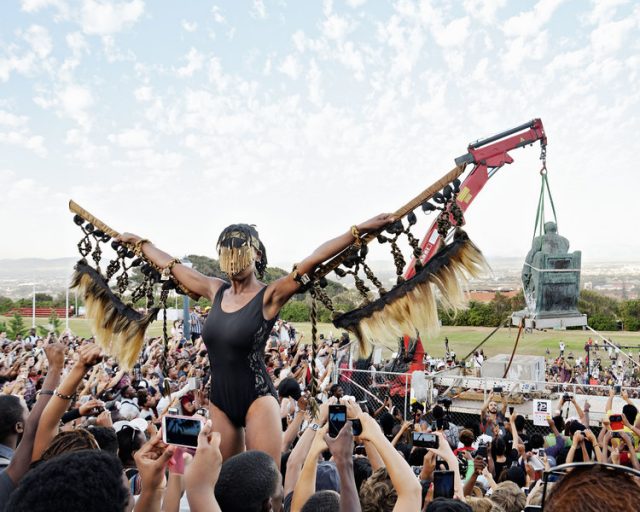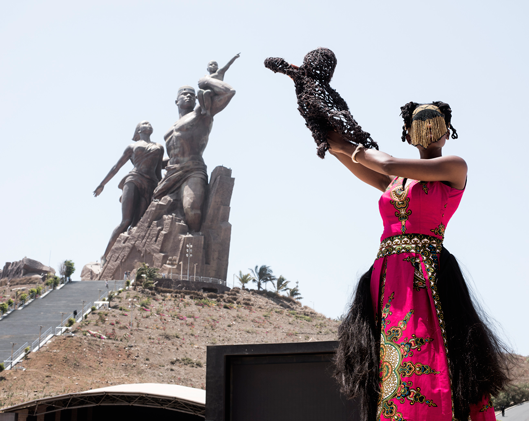Memory:
Black womxn
Faceless/though/many-faced
Neither “either/or” but
“both/and”
Standing
Wings out stretched
Sometimes statues are a way of making
ourselves real
And sometimes they are a place to lay our bones to rest
The first time I came across the work of the multi-award winning[1] artist and performer Sethembile Msezane it was through the recounting of a friend who had observed part of her Public Holiday series: a series of work that re-historicizes, problematizes, critiques and re-remembers the concealed violence upon which South Africa’s days of commemoration and holidaying are built. The particular work my friend had seen was Msezane’s Untitled (Heritage Day), performed in 2013. For those of us who have fallen victim to the collective amnesia that is our post-1994 Rainbow Nation inheritance, it would be understandable if the history of ‘Heritage Day’ (also affectionately and unironically nicknamed ‘Braai Day’) is unknown. Admittedly, my own knowledge of the history of September 24 was also lacking beyond the fodder of the Rainbow Nation PR machine.
History Lesson:
In pre-1995 KwaZulu Natal, 24 September was commemorated as Shaka Day, in remembrance of the Zulu king, Shaka kaSenzangakhona. In 1995, the Public Holidays Bill was presented to Parliament with 24 September absent from the list. This was contended by the Inkhata Freedom Party (IFP), a party with a majority Zulu partisanship/constituency. Parliament and the IFP came to a resolution that the day would be commemorated as ‘Heritage Day’. A legacy of the legal erasure of black South Africans from the legal framework of their homeland.
Untitled (Heritage Day) was the first in Msezane’s Public Holiday series, initiating a body of performative work that spanned two years. In these works, Msezane re-contextualizes and re-remembers the physical geography of the Cape Town CBD and its monuments. Not only does Msezane’s work operate at the level of race, contesting the concrete representation and ionization of whiteness and the legacy of black subjugation in the form of monuments in the Cape Town architectural scape but the work counterposes this layer of critique by gendering the lens.
In the series, Msezane performs her gendered body as inextricably linked to her racialized body. Heritage Day sees her in the traditional, celebratory garb and adornments of uMemulo (the coming of age ceremony for women in Zulu tradition). The performance of these signifiers operates as a critique not only of the white/rainbow-washing of September 24 but also as a critique of the valorization of historic, masculine figures (such as Shaka kaSenzangakhona) and the implicit invisibilization of female figures. This counterposition then becomes an intersection, the crossing of which is the body of Msezane. The lens is not only racial, but cultural; not only cultural, but gendered; not only contemporary but a recapitulation of a history of erased black femininities.
The layered didacticism of Msezane’s work is, for me, one of the pivotal axes of her work. For a people (here, I speak specifically of black South Africans and black womxn and femmes) that have had their history effectively erased under the rhetoric of non-racialism it is a necessary and urgent kind of activism to be part of the project of unearthing these erased histories. Furthermore, not only to unearth them but to critically engage with them. To re-remember ourselves and our bodies into the canon of history. It is through the concerted projection of the image of ourselves into these spaces (the public and the imaginary) that we can begin to have a more complete, self-curated image of ourselves outside the lens and dictates of whiteness.
Arjun Appadurai, a contemporary socio-cultural anthropologist, wrote in Modernity at Large (1996) that:
“the imagination has become an organized field of social practices, a form of work (in the sense of both labor and culturally organized practice), and a form of negotiation between sites of agency (individuals) and globally defined fields of possibility.”
This offers us a way of understanding the work of art in the present moment as an active form of labour that operates to achieve a myriad of divergent functions. Through the processes of constructing images, there is a particular kind of imagined world that is being represented. If we understand ‘the imagined’ to be no less real than ‘the observable’ then it follows, existentially, that that which goes unimagined and is unobservable does not exist. Herein lies the importance of work such as Msezane’s. Work that projects images of the observable and imagined worlds of a particular iteration of blackness. Representations of the known and the speculated; the remembered and the re-remembered.
In ‘Kwasuka Sukela’, Msezane interrogates representations and erasures of black femininity in the observable public and private domain. Revisiting contested sites of memory in South Africa, Senegal and Great Zimbabwe, Msezane performs the re-remembering of the canon of black history on the African continent. In So Long a Letter, performed alongside the African Renaissance Monument, Msezane recreates the now famous and contentious image of the monument with the male (supposedly, father/husband figure) role removed. This reads as a critique of normative representations of the nuclear family. Particularly, in the context of the monument where the representation of the black, nuclear family; father/husband, mother/wife and child; is presented as aspirational. Msezane stands, defiantly alongside the statue with child held up high. An homage to single motherhood; to black mothers raising black children in a world that would have them erased. Here the convergence of the public and private in relation to representation is a forefront theme.
With ‘Kwasuka Sukela’, Msezane counterposes representations of black femininity in the observable realm (in the form of monuments and geographic locales) with imaginings of representation in the non-observable world, the world of memory and speculative reimagining. A dialectic between the public and private; the empirically known and the speculated/intuited. By positioning representations of herself in locatable geographies alongside representations of herself in imagined and ephemeral realms (as in Abaphansi-Amawele akwaMsezane), Msezane offers an interrogation into the nature of memory. Who is allowed to be remembered and memorialised? What happens to those who go unremembered? How do we remember those who have past and have not been memorialised? How do we name our faceless ancestors? The work of honouring and memorialising our ancestors is sacred work. Not only for the purposes of laying them to rest but so that we can become recognizable to ourselves.
Msezane’s work operates as an invocational, devotional ancestral nexus. Her work creates a psychosphere of ancestral energy that is reflected in those who attend her exhibitions. At every exhibition of hers and the collective of which she forms a part, iQhiya, there has been a majority of young black attendees. This is no accident. The audience for whom this work is intended is very clear. And though no one is denied entry it is clear for whom and of whom the work is representational. Upon speaking to a friend of mine (a young, black womxn working in Cape Town at the time) whom I attended the iQhiya exhibition with at the AVA Gallery in Cape Town in April of 2016, she recounted how the energy that the space had cultivated was so recognizably black and feminine. “It’s the first and last time I’ve felt safe in the CBD in Cape Town” she recounted.
At Msezane’s Master’s exhibition ‘Kwasuka Sukela’ at the Michaelis School of Fine Art, I had a similar experience when observing her works Signal Her Return I, Signal Her Return II and Abaphansi Amawele akwaMsezane. They were presented in a separate room from the rest of the exhibition; upstairs, in low lighting with candles burning and a soundscape of whispering voices. The invocational, spiritual energy cultivated in that room was palpable. This forms another important axes of Msezane’s work: ancestral memory. Once again, for a people that have historically had their spiritual beliefs denounced and relegated to ‘folk’ medicine, the necessity for a safe space to understand communion with one’s ancestors is dire. Though by no means the only avenue to accessing this realm Msezane presents an image of what ancestral, devotional work looks like thereby not only paying homage to this practice but offering onlookers an opportunity to question their own beliefs and connections to their ancestors and the ancestral plane.
The Afromexicana poet Ariana Brown from North America, says the following: “… it is okay not to know the name of your ancestors/ to have lost the specifics/ The Western world would have you believe that only what is written is true”. Msezane’s work operates as a mechanism of re-remembering both our named and unnamed ancestors. Those whom history refused to document but have lived on in the psychosomatics of their descendants. Msezane’s work operates as a vindication of inter-generational memory and a love letter to all those young, black South Africans who have been dispossessed of their history; an offering of return.
Sethembile Msezane’s ‘Kwasuka Sukela’ is on exhibition at Gallery MOMO, Cape Town until 18 March 2017.
[1]Msezane’s awards include: TAF & Sylt Emerging Artist Residency Award winner (TASA) (2016), being the first recipient of the Rising Light award at the 5th edition of the Mbokodo Awards (2016), and the Sasol New Signatures Merit Award (2015)











